In The Hamilton Project book “Tackling the Tax Code: Efficient and Equitable Ways to Raise Revenue” (Nunn and Shambaugh 2020), leading economists and other experts offered a range of detailed proposals for better tax policies that would raise revenue in a progressive and growth-friendly manner. That book includes policy proposals for several issues, including a value-added tax, a financial transactions tax, wealth and inheritance taxes, better enforcement and administration of old and new tax laws via enhanced Internal Revenue Service resources, and fixing the broken corporate and international tax systems. On that last point, Kimberly Clausing[1] contributed a policy proposal intended to raise additional revenue from U.S. multinational corporations in efficient, equitable ways (Clausing 2020a). Congress is currently considering some of the essential aspects of Clausing’s proposal.
In this set of economic facts, The Hamilton Project and the Tax Law Center at NYU Law present background on the international corporate tax proposals that U.S. lawmakers are currently considering, including how those proposals would connect to a new multilateral agreement on international corporate taxation. This paper first describes the following issues:
- How current law allows U.S. multinationals to substantially lower their effective worldwide tax rates by shifting their profits abroad.
- How proposals to reform the U.S. taxation of multinationals, building on the basic approach to corporate international tax policy in tax legislation enacted in 2017 (known as the Tax Cuts and Jobs Act of 2017 [TCJA]), seek to raise revenue and reduce profit shifting.
- How tax proposals being considered by U.S. lawmakers and the new multilateral deal on international corporate tax are intended to be mutually supportive, maintaining the competitiveness of the United States as a location for investment and for corporations to reside.
It then presents six facts to illustrate the drivers and goals of current reform proposals. Because this paper is focused on U.S. reforms that Congress is currently considering as well as on the new multilateral deal, it does not describe or assess the many alternative domestic and multilateral reforms that would take tax law in a fundamentally different direction.[2]
Related Content

Emily Moss, Ryan Nunn, Jay Shambaugh
January 28, 2020

Kimberly Clausing
January 28, 2020
2022
Online only
3:00 pm - 4:00 pm EDT
Current Law
Currently, the statutory tax rate on corporate profits earned in the United States is 21 percent. The foreign profits earned by U.S. multinationals generally do not face that same rate (as they would under a pure worldwide international tax system), but neither are those foreign profits completely exempt from U.S. tax (as they would be under a pure territorial system). Instead, the United States operates under the hybrid international tax system established by the TCJA.[3] Specifically, a U.S. multinational is intended to pay a minimum rate of 10.5 percent on most of its foreign profits (set to increase to about 13 percent after 2025). This minimum tax provision is known as GILTI (global intangible low-taxed income; see Congressional Research Service [CRS] 2021a).
Many other provisions of law further complicate the story, and the actual tax rate that U.S. multinationals pay on their domestic and foreign profits can be far different from either of those headline statutory rates (i.e., 21 percent or 10.5 percent). Deductions, exemptions, and credits for specific types of investment or activities can lower tax rates on profits from certain domestic and foreign investments even further. For example, U.S. multinationals can get a special rate starting at about 13 percent for income they receive from certain sales outside of the United States; this foreign-derived intangible income (FDII) comes from exporting products tied to intangible assets such as patents, trademarks, copyrights, and other intellectual property held in the United States. And the GILTI minimum tax applies only to foreign profits that are greater than 10 percent of a company’s investment in tangible assets, such as factories, in foreign countries, meaning that some foreign profits can face an effective rate of zero. On the other hand, some foreign profits, including profits from passive investments, face the 21 percent rate immediately rather than the lower GILTI rate.[4] A separate minimum tax on some amounts that U.S. corporations pay to related foreign companies, the Base Erosion and Anti-Abuse Tax (BEAT)—currently 10 percent—is meant to deter anyone using those payments to erode the U.S. tax base (see CRS 2021b). The potential application of both the GILTI minimum tax and the BEAT to the same income can also lead to marginal tax rates on such income above 21 percent.[5] After taking into account all of the different provisions that can lower or raise their taxes, U.S. multinationals paid an effective worldwide cash tax rate on their book profits of 8.8 percent in 2018 (see Fact 1), well below the headline statutory rates.
U.S. multinationals still have an incentive and opportunity to report their profits or locate their investments offshore to lower-tax countries to lower their global tax rates (see Fact 2). The GILTI minimum rate is still far lower than the domestic statutory rate, and the way that the GILTI rate is calculated allows tax on profits from high-tax countries to shield those from tax havens, creating a net incentive to report profits as having been made offshore rather than in the United States (see Fact 3).[6] Another reason that the worldwide tax rate is below even the minimum GILTI rate is because some foreign profits are exempt from the GILTI minimum tax. As a further example, some domestic investments give rise to federal tax credits that result in negative marginal effective tax rates.
Reform Proposals
Lawmakers are considering proposals to address some of those issues while they retain and build on the basic hybrid framework that the TCJA established. The U.S. House of Representatives has passed proposals that include raising the GILTI minimum tax rate on foreign profits to about 15 percent (Build Back Better Act 2021). The House would also apply the minimum tax on a country-by-country basis, which would help prevent taxes paid in foreign high-tax jurisdictions from being used to shield income reported in tax havens from U.S. tax. It also includes changes to other provisions, such as the BEAT. President Biden’s fiscal year 2023 budget would make further changes, including a higher GILTI rate (U.S. Department of Treasury 2022). Some provisions of the House bill and the president’s budget proposals would cut taxes for multinationals by addressing provisions of the TCJA that have led to outcomes that have been criticized as overly punitive or unintended. But, on net, both sets of proposals would require U.S. multinationals to pay higher effective tax rates, on average, and would raise U.S. tax revenues (Joint Committee on Taxation [JCT] 2021b; U.S. Department of the Treasury 2022).
Those significant changes to tax policy would bring the U.S. system more in line with the new consensus on international corporate tax policy that more than 130 countries agreed to late last year (2021) and are now working to implement through internal policy changes.[7] The consensus was developed by the Organisation for Economic Co-operation and Development (OECD)/Group of 20 (G20) Inclusive Framework on BEPS (Base Erosion and Profit Shifting) (OECD 2021a). The six facts presented in this paper illustrate the motivations and goals for many of the features of that framework.
One development that drove the need for an updated global framework—the first fundamental remaking of the global tax system since the 1920s—is that much corporate income today flows from intangibles such as patents, trademarks, copyrights, and other intellectual property, as well as digital services that are not strongly connected to physical activity. But the old framework focused on physical activity as a key way to determine which countries could tax certain profits—and struggled to deal with profits flowing from intangibles. This means that a major concern has been the use of intangibles to shift profits, such as by holding patents and other intellectual property in tax havens and attributing as much profit as possible to that intellectual property. And policymakers in market countries in which digital services multinationals have been doing business (but without a physical presence) have been concerned about their countries’ inability to tax any part of the profits flowing from such services under their corporate income tax. Furthermore, the old system focused on preventing double tax on businesses doing business across borders, so that the same income would not be taxed by multiple jurisdictions and so cause very high effective rates. But the old system was not focused on potentially large amounts of corporate profit escaping tax altogether. In that vein, effective corporate tax rates are now considerably lower than statutory rates. For example, as noted in Fact 1, the average tax rate U.S. corporations pay on their profits reported in the United States was 7.8 percent, and the average tax rate on their profits worldwide was 8.8 percent for 2018.
The Inclusive Framework on BEPS deal has two pillars.[8] Pillar 1 is intended to stem the tide of unilateral measures, like digital service taxes, by countries seeking a share of corporate income based on the consumers in their country. Pillar 2 seeks to address the problem of tax competition. It does that largely by adopting a multipronged minimum tax intended to ensure that the income of covered multinationals is subject to at least 15 percent tax in each jurisdiction in which it operates. If a multinational’s parent jurisdiction does not impose the minimum 15 percent tax (or is not treated as doing so because its tax does not follow the agreed-on rules closely enough), other countries could collect revenue by topping up the tax on that multinational’s income. The global deal’s minimum tax was inspired by the GILTI minimum tax introduced in the TCJA. But, among the differences between the two, the global deal has a higher rate and the requirement that it be calculated on a country-by-country basis.
Those two pillars attempt to address concerns about: multinationals’ ability to shift profits into tax havens so that they paid little or no tax anywhere in the world; countries in which multinationals might do business or be based competing for that activity and associated tax revenue by lowering their tax rates in a race to the bottom (see Fact 4); and uncoordinated, unilateral responses being undertaken by market economies to tax digital services that were otherwise very lightly taxed by usual corporate taxes.
The Mutually Supportive Nature of the Proposals
The changes being considered by U.S. lawmakers to move to conform to the global deal are estimated to raise substantial tax revenue (see Fact 5). At the same time, those changes are unlikely to significantly affect corporations’ decisions about where to locate their residence for tax purposes. The tax rate that in theory matters most for determining corporate residence is the average tax rate that corporations would face on their worldwide income if they were resident in different countries. Under the Inclusive Framework on BEPS deal, differences in average rates should decrease by virtue of the floor on the rates moving from 0 percent to 15 percent.
The Inclusive Framework on BEPS deal also increases the benefits and reduces the cost for the United States of adopting such proposals. Global adoption of similar corporate tax policy would reduce the potential tax benefit for U.S. companies of leaving the United States or starting up elsewhere, since they will face at least a minimum 15 percent rate on their worldwide income regardless of their domicile. Locating real investment (or paper profits) in other countries to reduce U.S. tax would similarly become less lucrative as the global floor on effective rates rises from 0 percent to about 15 percent. Moreover, as an active participant in the global effort to reform international corporate tax policy, the United States would benefit from the reversal in the trend for countries to unilaterally impose taxes in a way that targets particular multinational corporations (see Fact 6).
If the United States remains outside the coordinated international tax system and U.S. multinational corporations are deemed to pay less than the minimum tax, foreign countries would coordinate to collect additional taxes from U.S. multinationals. Alternatively, if the United States participates in the Inclusive Framework on BEPS deal and conforms its tax policy to international standards, the likelier outcome is a playing field that is more level for U.S. multinational corporations and higher U.S. tax revenue. In addition, the United States can likely go beyond international standards and still be an attractive location for investment and company headquarters. The relative strength in U.S. markets, institutions, and labor policy (among other non-tax dimensions) likely means that the United States can sustain somewhat higher tax rates than the global floor (and revenues raised, if used wisely, could strengthen those advantages). Furthermore, U.S. leadership on international tax reform may encourage other countries to implement the consensus standards.
1. US multinationals paid an effective worldwide cash tax rate of 8.8 percent in 2018.
In 2018, U.S. multinationals paid a cash tax rate of 8.8 percent of their total worldwide book income (Figure 1).[9] This average effective tax rate is lower than the three statutory tax rates aimed at income related to foreign activities: the FDII rate (13.125 percent), the GILTI minimum tax rate (10.5 percent), and the BEAT minimum tax rate (10 percent). Average cash tax rates paid by U.S. corporations are also considerably lower than the 15 percent minimum tax rate proposed in the Inclusive Framework on BEPS deal, which in turn is lower than the 18 percent cash tax rate U.S. corporations pay on their income reported across the United States’ top 10 trading partners. In addition, the average effective cash tax rate on worldwide income is much lower than the headline domestic statutory corporate tax rate of 21 percent, as is the average cash effective tax rate on income reported in the United States, which was only 7.8 percent for 2018.
Low effective tax rates are in part the result of provisions targeted to certain activities or types of income that take the form of exemptions and deductions from the headline statutory rates, credits against tax, and provisions that allow for taxes to be delayed. Therefore, depending on the type of investment or activity and how it is financed, there can be a wide range of effective tax rates on corporate profits. In fact, the effective tax rate on certain new investments (especially if debt-financed) can be negative—that is, rather than reducing profits on these investments, the tax system can add to profits from these investments.[10] For foreign profits, specific provisions that can lower taxes beyond the headline rate include the exemption from the GILTI minimum tax of income totaling 10 percent of a company’s offshore tangible investments. But as Fact 2 explains in more detail, another major way that multinationals are able to lower taxes on their worldwide profits is by shifting income to certain low-tax foreign countries for tax purposes.
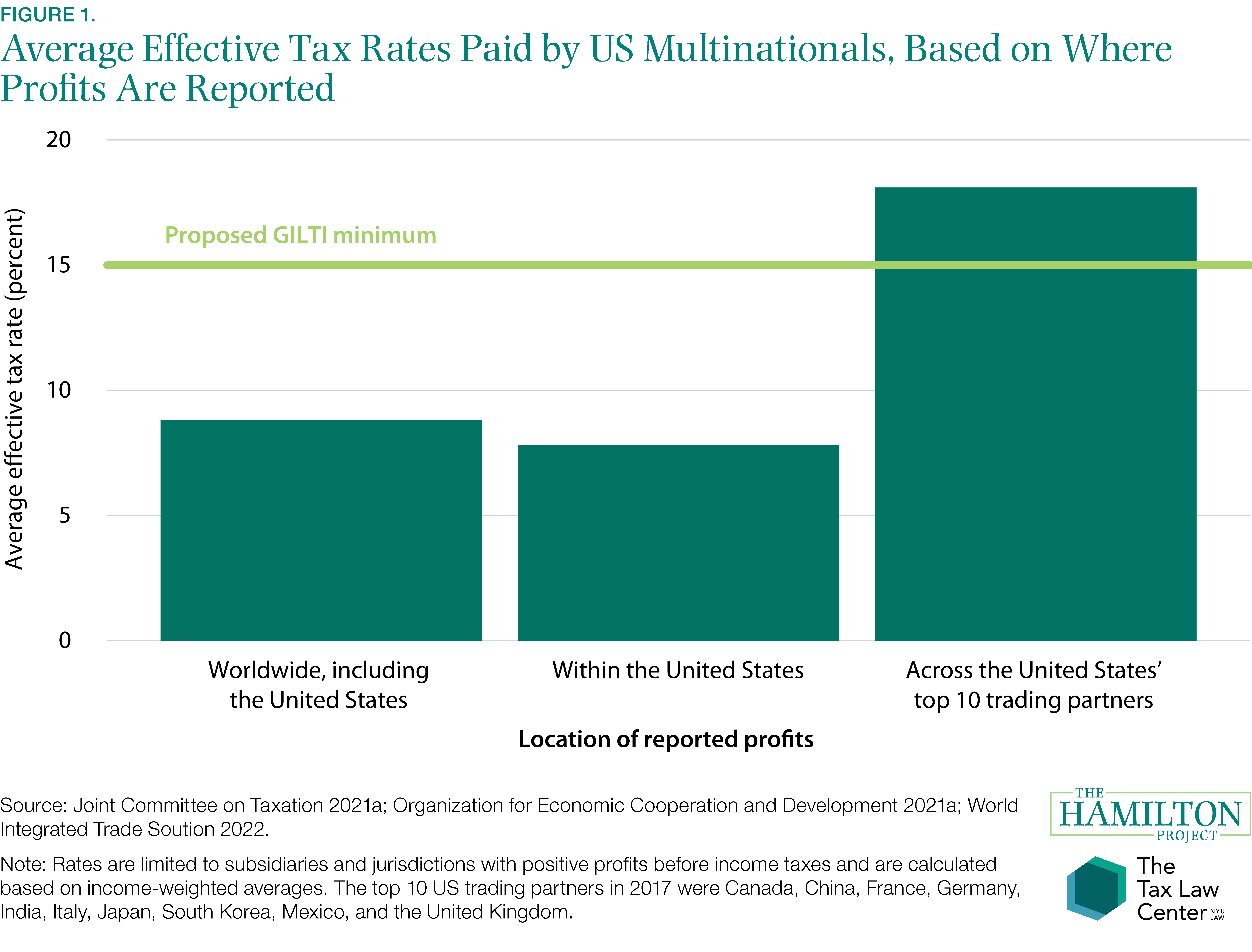
2. US multinationals still shift profits into lower-tax countries.
To lower effective tax rates, multinational companies can use an array of techniques to profit shift; that is, they can report for tax purposes their profits as having been made in jurisdictions where they can achieve lower tax rates without changing the location of their real economic activities.[11] If these profits were reported in the United States, tax liability would be computed using U.S. domestic tax rates at up to 21 percent. Instead, the liability is either computed using the GILTI minimum tax at a targeted 10.5 percent rate, or the profits are entirely exempt from U.S. tax. Furthermore, the way that the GILTI minimum tax is computed can in some circumstances reward reporting profits in tax havens.
In 2019, U.S. multinationals reported more than half of their foreign earnings in the Big Seven tax havens (Figure 2A). The share of U.S. multinationals’ profits booked in these tax havens bears little relationship to the share of employees or physical assets that companies have in these tax havens, factors that may be more indicative of their real business activity (Figure 2B). For example, the share of those firms’ tangible assets in those tax havens was under 5 percent while the share of pretax profits was over 15 percent. Indeed, corporate profits booked in Bermuda (the jurisdiction where the largest share of U.S. multinationals’ profits is booked) were over four times the GDP of Bermuda in 2019.
The TCJA reduced the domestic corporate rate and introduced the minimum tax on foreign profits; the Congressional Budget Office (CBO) estimated that companies would profit shift roughly $65 billion less per year than under previous law (CBO 2018). Nonetheless, profit shifting is still significant, with companies estimated to be shifting more than $300 billion each year in profits out of the United States, and the share of foreign earnings reported in tax havens little changed.[12] At the same time, per dollar of profit shifted offshore, the cost to the United States is less now than it was before the TCJA because the law reduced the spread between the top U.S. tax rate on foreign profits and the top U.S. tax rates on domestic profits.
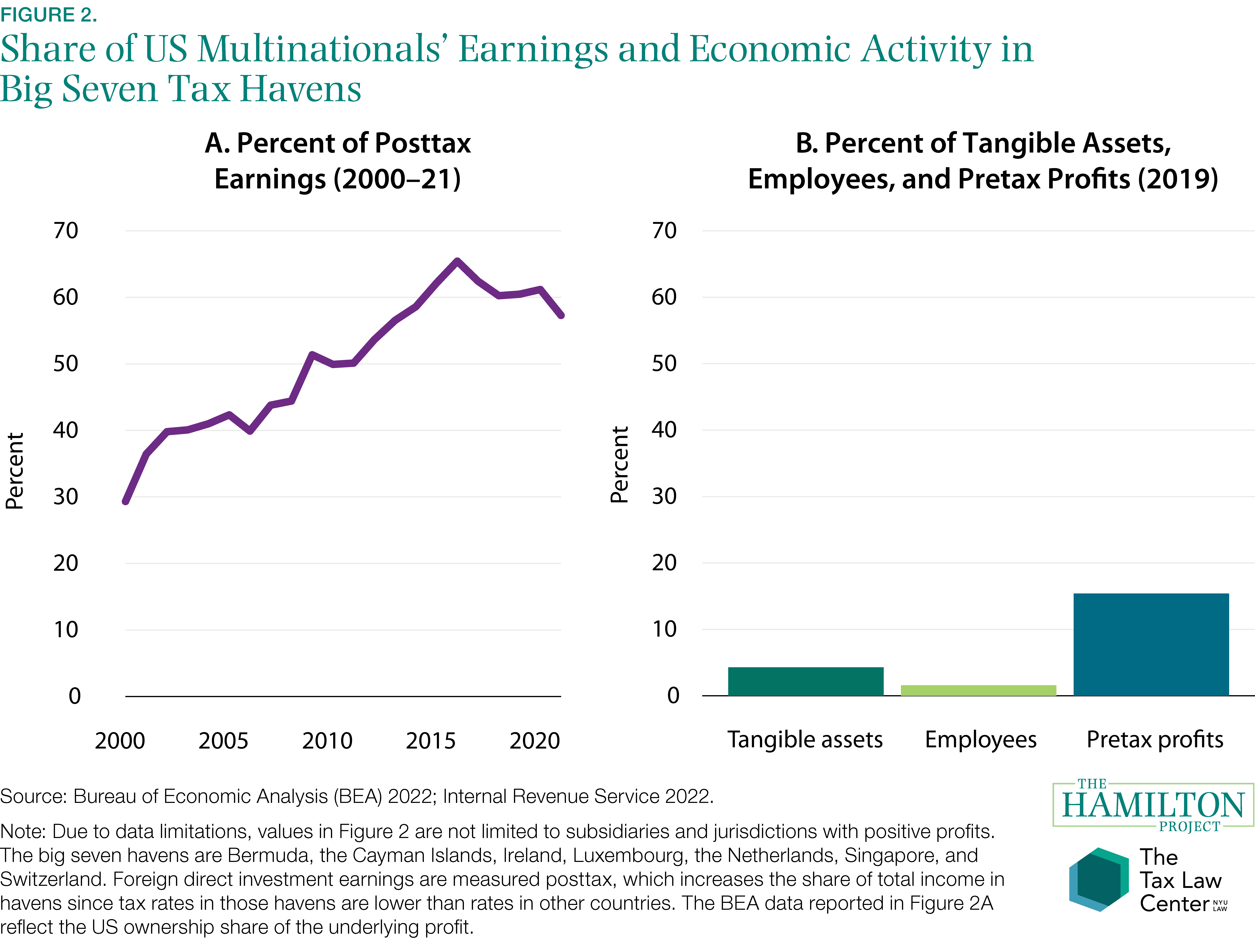
3. US multinationals can use the variation in tax rates across countries to lower their tax liability.
In 2019, the weighted average foreign tax rate on U.S. multinationals’ positive corporate income reported in Group of Seven (G7) countries was 13.9 percent, while the tax rate in tax havens was as low as 0.7 percent (Figure 3). The amount of GILTI minimum tax on a multinational’s foreign profits is calculated by looking at the multinational’s global income and foreign taxes on an aggregate basis, rather than by looking at its income and taxes for each country separately (i.e., on a country-by-country basis). This blending or averaging feature of the GILTI minimum tax calculation means continued incentives to locate profits offshore.
For example, if a multinational already generates substantial profits in high-tax foreign countries, it will have an incentive to book profits in tax havens because no U.S. tax will apply, as long as the total taxes paid are high enough to avoid any GILTI tax. And, the blending feature can create an incentive to move U.S. profits or even real activities to foreign countries with a tax rate similar to that in the United States, or even somewhat higher. By paying higher taxes on reported foreign income instead of on domestic income, the higher taxes can be blended with lower taxes paid on reported income in tax havens—thus avoiding the GILTI tax.
Moving from blending to a country-by-country calculation, in addition to increasing the GILTI rate, would narrow the gap between the domestic rate and GILTI rate on foreign profits: U.S. multinationals would pay at least the GILTI minimum tax rate on income in each country in which they operate. This would help move the United States toward consistency with the Inclusive Framework on BEPS deal and would reduce incentives that result from blending under the current GILTI calculation to profit shift or to offshore real activities.
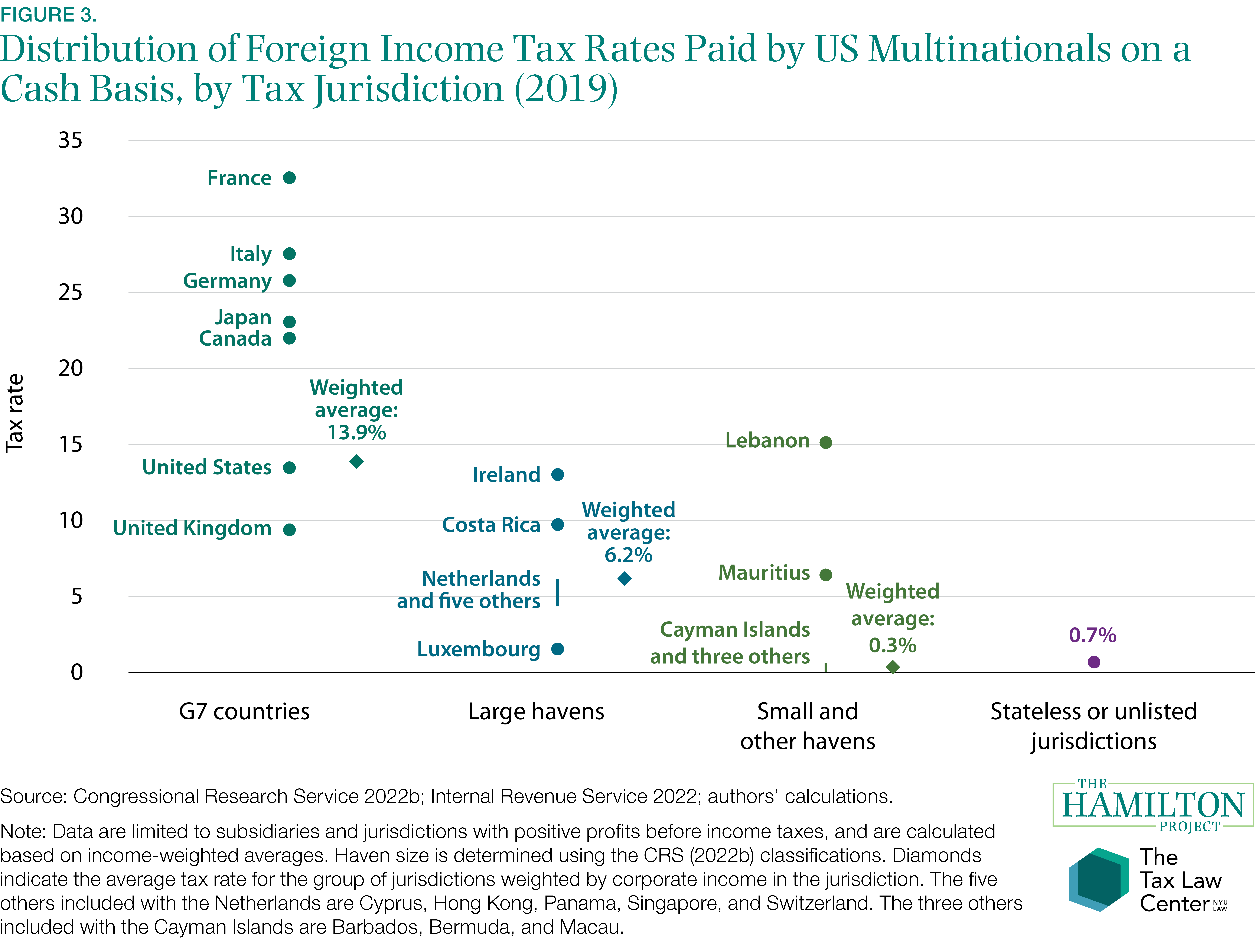
4. Competition between countries has created a race to the bottom in corporate taxes.
Decades of tax competition between countries to attract multinationals’ business has led to declining statutory corporate tax rates (Figure 4) as well as to stateless income (i.e., income that is not subject to significant tax in any country) (Kleinbard 2011). In order to reduce tax competition and raise effective tax rates, Pillar 2 of the Inclusive Framework on BEPS deal would ensure that multinationals’ worldwide income will be subject to a minimum tax rate of 15 percent. That minimum rate is intended to effectively eliminate the use of tax havens by reducing the potential tax benefits from shifting profits out of higher-tax jurisdictions and into tax havens that have effective tax rates approaching zero. As a corollary, countries can implement tax policy that raises corporate tax revenue with less concern that such policies create incentive for companies to move their tangible and intangible assets to other countries to lower their tax liabilities.
Although higher tax rates reduce investors’ expected after-tax rate of return, any anticipated reduction in investment in the United States from this channel is small. To provide context for how small such effects are found to be, the large cut in corporate taxes under the TCJA had little discernible positive impact on investment (see Edelberg 2021; Furman 2020b; Gale and Haldeman 2021b). In contrast to the average tax rate, largely the focus of the international tax reform proposals, the tax rates that in theory matter most for new investment within the United States are the effective marginal tax rates to new investments, which in the United States for certain investments would still be quite low and even negative, especially if it were debt-financed.
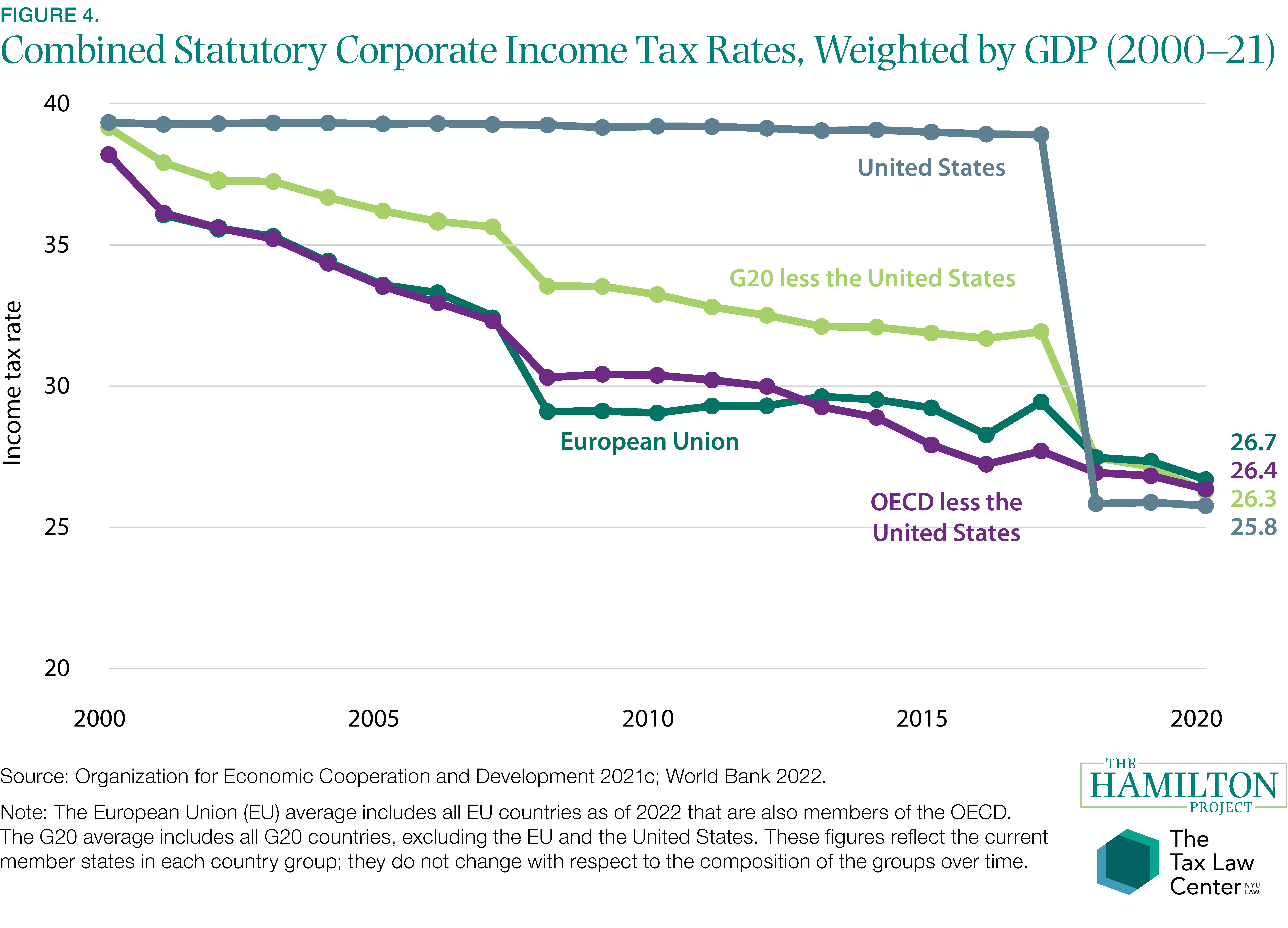
5. Corporate tax revenues in the United States are at very low levels, internationally and historically.
Even as domestic corporate profits as a share of GDP have increased over the last three decades, U.S. corporate tax revenue has remained relatively flat (Figure 5A).[13] Whether revenues as a share of GDP are measured by the Bureau of Economic Analysis (shown in Figure 5A) or by the OECD (shown in Figure 5B), the share hovered between 1 percent and 3 percent from 1985 to 2020. In 2020, the share was close to 1 percent, which is roughly tied with 2018, 2009, 2002, and 1983 for the lowest in many decades. The United States currently collects much less in corporate tax revenue as a share of GDP than the OECD average (Figure 5B).
Of course, there are many drivers of the low level of U.S. corporate tax revenue relative to profits, including policies that affect only domestic corporations and those that have created greater incentives over time for business owners to organize their businesses in such a way that income is taxed at the individual income tax rate (with that pass-through income not facing the corporate tax rate) (Tax Policy Center 2021). Reforms to these areas could also raise revenue and complement reforms that affect only multinational corporations.[14]
Changes to the U.S. international tax regime that lawmakers are currently considering would raise significant amounts of revenue in the United States. For example, the proposed international tax changes in the House-passed bill—which include raising the GILTI rate to about 15 percent and computing it on a country-by-country basis as well as moving the BEAT in the direction of the minimum tax under Pillar 2’s undertaxed profits rule—would raise a combined $279 billion over 10 years.[15] Under the undertaxed profits rule, if a multinational’s parent jurisdiction does not impose the minimum 15 percent tax (or is not treated as doing so because its tax does not follow the minimum tax rules closely enough), other countries could collect the resulting shortfall in taxes.[16]
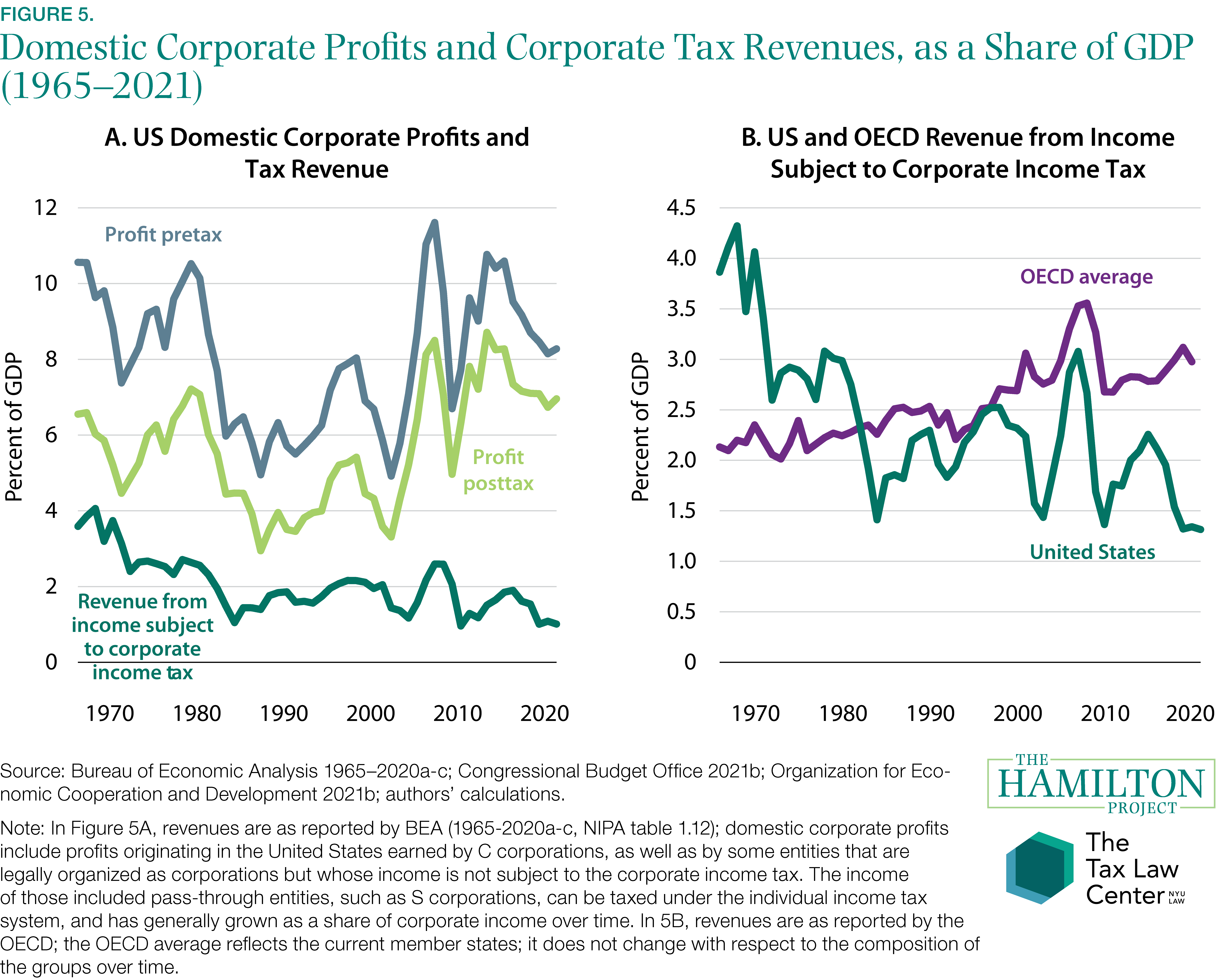
6. A failure for the United States to engage in the coordinate multilateral tax reform creates risks.
International coordination on tax policy is necessary to prevent countries from using tax policy strategically to facilitate corporations shifting profits to chase ever-lower tax rates and from unilaterally imposing taxes that arguably target particular multinationals. For example, the introduction in some countries of digital services taxes (DSTs), an excise tax that a country levies on the sale of digital services (such as streaming services or advertising on global platforms) to customers in that country, have had features that led U.S. policymakers to claim that they unfairly targeted only large U.S. companies such as Facebook, Apple, Amazon, Netflix, and Alphabet (Google); see Figure 6.
Countries considering or adopting DSTs argued they had a claim to tax some of this corporate economic activity because it relied on their domestic markets. Furthermore, profits flowing from this activity were often going entirely untaxed due to profit shifting to tax havens. Because these taxes have significant effects on U.S. multinationals, they have raised the specter of retaliatory tariffs imposed by the United States, and an escalation of tit-for-tax tax and trade retaliatory measures (Palmer 2020).
DSTs are an example of how a lack of international coordination of tax policy could lead to a more incoherent patchwork of taxes that reduces a potential source of U.S. tax revenue while also creating volatility for companies doing international business. A lack of coordination could also lead to conditions that U.S. policymakers might view as penalizing U.S. corporations and potentially making them less competitive (Office of the U.S. Trade Representative 2021).
If the United States participates in the Inclusive Framework on BEPS and conforms its tax policy to international standards, the likely outcome is a playing field that is more level for U.S. multinational corporations and that will lead to higher U.S. tax revenue.
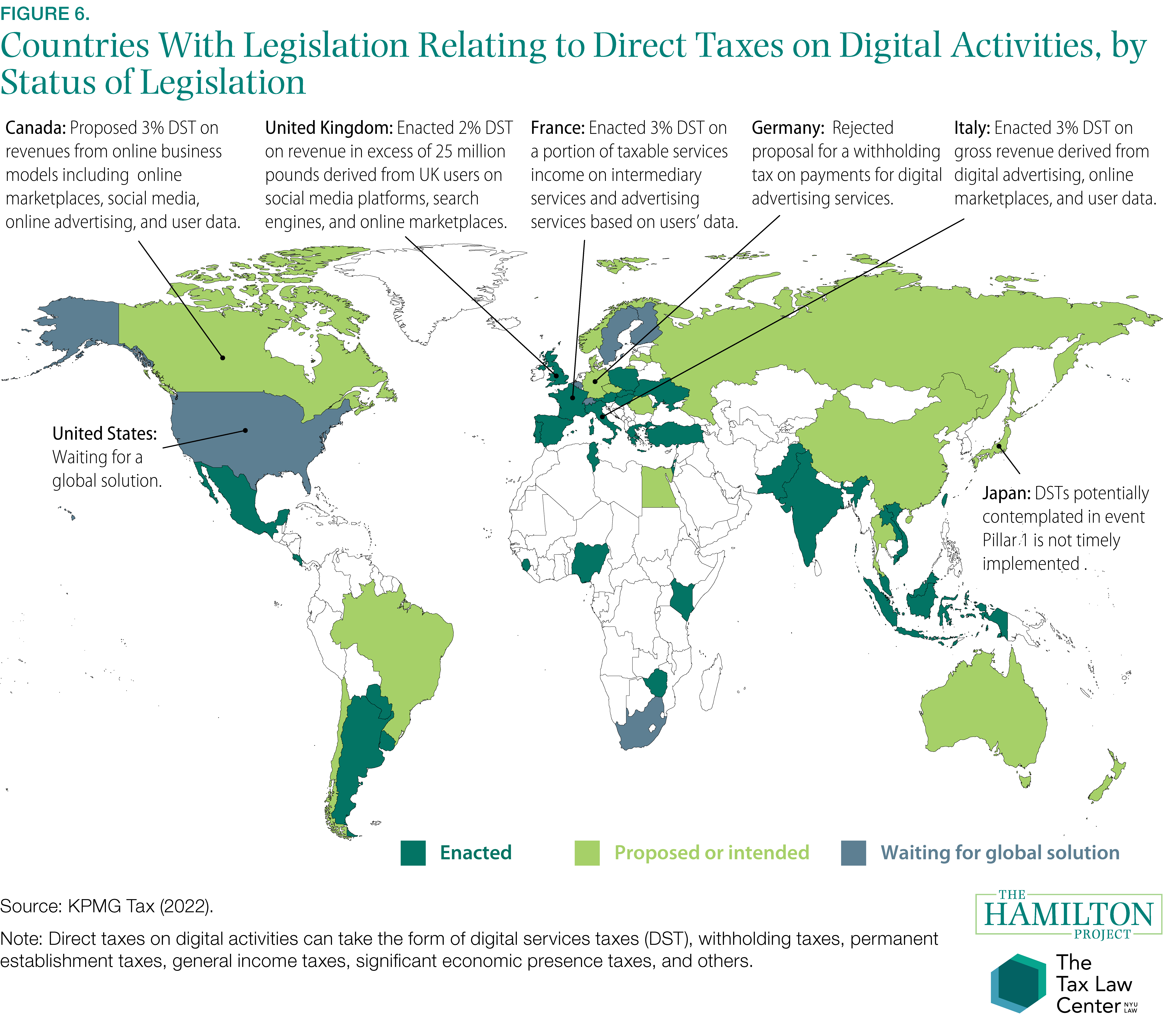
References
Auerbach, Alan J. 2010. “A Modern Corporate Tax.” Center for American Progress, Washington, DC.
Build Back Better Act. 2021. H.R. 5376, 117th Congress. Introduced September 27, 2021.
Bureau of Economic Analysis (BEA). 1965–2020a. “Corporate Business: Profits After Tax.”
Bureau of Economic Analysis, Suitland, MD. Retrieved from FRED, Federal Reserve Bank of St. Louis, St. Louis, MO.
Bureau of Economic Analysis (BEA). 1965–2020b. “Corporate Business: Profits Before Tax.” Bureau of Economic Analysis, Suitland, MD. Retrieved from FRED, Federal Reserve Bank of St. Louis, St. Louis, MO.
Bureau of Economic Analysis (BEA). 1965–2020c. “Gross Domestic Product (GDP).” Bureau of Economic Analysis, Suitland, MD. Retrieved from FRED, Federal Reserve Bank of St. Louis, St. Louis, MO.
Bureau of Economic Analysis (BEA). 2022. “U.S. Direct Investment Abroad: Balance of Payments and Direct Investment Position Data. Quarterly Data (by selected country and by selected industry): Income without current-cost adjustment.” BEA, Washington, DC. Accessed May 2, 2022, at www.bea.gov/international/di1usdbal.
Clausing, Kimberly. 2020a. “Taxing Multinational Companies in the 21st Century.” Policy Proposal, The Hamilton Project, Brookings Institution, Washington, DC.
Clausing, Kimberly. 2020b. “Five Lessons on Profit Shifting from the U.S. Country by Country Data.” Last revised January 13, 2021. Tax Notes Federal 169(9): 925–40.
Clausing, Kimberly. 2020c. “Howc Big Is Profit Shifting?” Available at SSRN: https://papers.ssrn.com/sol3/papers. cfm?abstract_id=3503091.
Congressional Budget Office (CBO). 2018. “The Budget and Economic Outlook: 2018 to 2028.” CBO, Washington, DC.
Congressional Budget Office (CBO). 2022a. “CBO’s Model for Estimating the Effect That Federal Taxes Have on Capital Income From New Investment” Working Paper 2022-01, CBO, Washington, DC.
Congressional Budget Office (CBO) 2022b. “The Budget and Economic Outlook: 2022 to 2032.” CBO, Washington, DC.
Congressional Research Service (CRS). 2021a. “GILTI: Proposed Changes in the Taxation of Global Intangible Low-Taxed Income.” IF11943. CRS, Washington, DC.
Congressional Research Service (CRS). 2021b. “Issues in International Corporate Taxation: The 2017 Revision (P.L. 115-97). R45186. CRS, Washington, DC.
Congressional Research Service (CRS). 2022a. “International Tax Proposals Addressing Profit Shifting: Pillars 1 and 2” In Focus-11874 (March 10, 2022). CRS, Washington, DC.
Congressional Research Service (CRS). 2022b. “Tax Havens: International Tax Avoidance and Evasion.” R40623. CRS, Washington, DC.
Driessen, Patrick. 2021. “About That 8 Percent Corporate Rate.” Policy Perspective, TaxNotes.com, May 10, 2021.
Duehren, Andrew. 2022. “Yellen Pushes Polish Prime Minister on International Tax Deal.” The Wall Street Journal, May 16, 2022.
Edelberg, Wendy. 2021. “Testimony of Dr. Wendy Edelberg, Director, The Hamilton Project, Before the United States Joint Economic Committee.” October 6. Joint Economic Committee, U.S Senate, Washington, DC.
Furman, Jason. 2020a. “How to Increase Growth While Raising Corporate Revenue.” Policy Proposal, The Hamilton Project, Brookings Institution, Washington, DC.
Furman, Jason. 2020b. “Prepared Testimony for the Hearing, ‘The Disappearing Corporate Income Tax’ by Jason Furman, Professor of the Practice of Economic Policy, Harvard Kennedy School and Department of Economics, Harvard University.” February 11. Committee on Ways and Means, U.S. House of Representatives, Washington, DC.
Furman, Jason. 2022. “A Global Tax System Is Good for the U.S.” Wall Street Journal, May 2, 2022.
Gale, William G., and Claire Haldeman. 2021a. “Taxing Business: The Tax Cuts and Jobs Act and What Comes Next.” TaxNotes, Falls Church, VA.
Gale, William G., and Claire Haldeman. 2021b. “The Tax Cuts and Jobs Act: Searching for Supply Side Effects.” Economic Studies, Brookings Institution, Washington, DC.
Internal Revenue Service (IRS). 2019. “Tax Year 2019 Country-by-Country Tables: Data Sources and Limitations.” IRS, U.S. Department of the Treasury, Washington, DC.
Internal Revenue Service (IRS). 2022. “Country-by-Country Report: Tax Jurisdiction Information. Major Geographic Region and Selected Tax Jurisdiction [2019].” IRS, U.S. Department of the Treasury, Washington, DC.
International Centre for Tax and Development. 2020. “At the Table, Off the Menu? Assessing the Participation of Lower-Income Countries in Global Tax Negotiations.” Working Paper 115, ICTD, Institute of Development Studies, Brighton, UK.
Joint Committee on Taxation (JCT). 2021a. “U.S. International Tax Policy: Overview and Analysis.” JCX-16R-21. JCT, Washington, DC.
Joint Committee on Taxation (JCT). 2021b. “Estimated Budget Effects of the Revenue Provisions of Title XIII—Committee on Ways and Means, H.R. 5376, The “Build Back Better Act,” As Passed by the House of Representatives.” JCX-46-JCT, Washington, DC.
Kleinbard, Edward D. 2011. “Stateless Income.” Florida Tax Review 11: 699–783.
KPMG Tax. 2022. “Taxation of The Digitalized Economy–LATAM Focus: Developments Summary.” KPMG, New York.
Nunn, Ryan, and Jay Shambaugh. 2020. Tackling the Tax Code: Efficient and Equitable Ways to Raise Revenue. Washington, DC: The Hamilton Project.
Office of the United States Trade Representative. 2021. “USTR Announces, and Immediately Suspends, Tariffs in Section 301 Digital Services Taxes Investigations.” June 2. Executive Office of the President, Washington, DC.
Organisation for Economic Co-operation and Development (OECD). 2020. “Effective Tax Rates.” OECD.Stat. OECD, Paris.
Organisation for Economic Co-operation and Development (OECD). 2021a. “OECD/G20 Base Erosion and Profit Shifting Project: Two-Pillar Solution to Address the Tax Challenges Arising from the Digitalisation of the Economy.” OECD, Paris.
Organisation for Economic Co-operation and Development (OECD). 2021b. “Revenue Statistics—OECD Countries: Comparative Tables.” OECD, Paris. Accessed May 2, 2022, at https://stats.oecd.org/index. aspx?DataSetCode=REV.
Organisation for Economic Co-operation and Development (OECD). 2021c. “Statutory Corporate Income Tax Rates.” OECD, Paris. Accessed May 2, 2022 at https://stats.oecd. org/Index.aspx?DataSetCode=CTS_CIT.
Palmer, Doug. 2020. “Digital Services Tax Dispute with the EU Heats Up.” Politico, Weekly Trade, June 19, 2020.
Sullivan, Martin A. 2018. “Economic Analysis: Two Approaches to Less BEATing on the GILTI.” TaxNotes.com, May 29, 2018.
Tax Cuts and Jobs Act of 2017 (TCJA), Pub.L. 115–97, Stat.:131 Stat. 2054.
Tax Policy Center (TPC). 2021. Tax Policy Center Briefing Book. The Urban Institute, Washington, DC Accessed on May 23, 2022.
U.S. Department of the Treasury. 2022. “General Explanations of the Administration’s Fiscal Year 2023 Revenue Proposals.” U.S. Department of the Treasury, Washington, DC.
Wearden, Graeme, and Larry Elliot. 2022. “’Historic’ Global Tax Deal on Multinationals Delayed Until 2024.” The Guardian, May 24, 2022. https://www.theguardian.com/business/2022/may/24/historic-global-tax-deal-on-multinationals-delayed-until-2024.
World Bank. 2022. “GDP (Current US$).” World Bank, Washington, DC. Accessed May 9, 2022, at https://data.worldbank. org/indicator/NY.GDP.MKTP.CD?view=chart.
World Integrated Trade Solution. 2022. “United States Trade Balance, Exports and Imports, by Country and Region 2017.” World Integrated Trade Solution, World Bank, Washington DC. Accessed May 23, 2022, at https://wits.world- bank.org/CountryProfile/en/Country/USA/Year/2017/ TradeFlow/EXPIMP#.
Wyden, Ron, Sherrod Brown, and Mark Warner. 2021. “Overhauling International Taxation.” Senate Finance Committee, Washington, DC. https://www.finance.senate.gov/imo/media/doc/040121%20Overhauling%20International%20
The Brookings Institution is financed through the support of a diverse array of foundations, corporations, governments, individuals, as well as an endowment. A list of donors can be found in our annual reports published online here. The findings, interpretations, and conclusions in this report are solely those of its author(s) and are not influenced by any donation.
Authors
-
Acknowledgements and disclosures
The authors are grateful to Lauren Bauer, Patrick Driessen, Jason Furman, and William Gale for their insightful comments. Kathleen Bryant, Sara Estep, and Natalie Tomeh provided excellent research assistance. Lastly, the authors would like to thank Jeanine Rees for all of her help with the graphic design and layout of this piece.

March 6, 2024

Judy Marks
March 6, 2024

Roberto Velasco Álvarez
March 6, 2024



